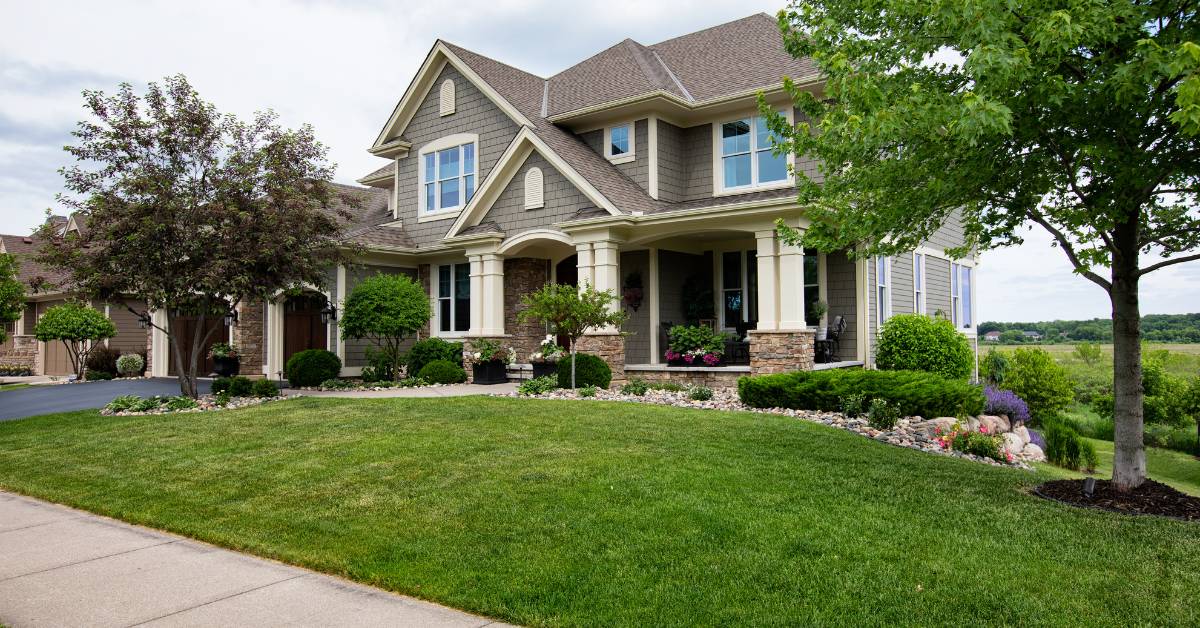Buying a home is an exciting journey.
And finding the right mortgage is a crucial part of that adventure. If you’ve been exploring your options, you might have come across USDA loans.
These loans, backed by the United States Department of Agriculture, are known for their benefits like zero down payment and competitive interest rates. But, as with all great things, there are a few hiccups to consider.
So, let’s dive into the not-so-rosy side of USDA loans!
What Are USDA Loans?
USDA loans help eligible borrowers purchase homes in rural and suburban areas. These loans are designed to promote homeownership in designated rural areas by offering favorable terms and features to qualified borrowers.
They come with 100% Financing, low-interest rates, and flexible credit requirements. However, keep in mind that they are only available to eligible borrowers who meet specific income limits and other criteria.
You can refinance a home with a USDA loan or build a new home with a USDA construction loan. Both come with unique eligibility requirements.
What Are the Pros and Cons of Using a USDA Loan?

If you’re considering applying for a USDA loan, here’s a scope of the pros and cons of financing a house with a USDA loan.
The pros of using a USDA loan include the ability to finance 100% of the home’s purchase price (no down payment required), competitive interest rates, and the availability of both direct loans and loan guarantees.
The cons of using a USDA loan include geographic restrictions (only available in eligible rural and suburban areas), income limits based on household size and location, and the requirement for mortgage insurance.
What Are the Eligibility Requirements for a USDA Loan?
Just like many other mortgage options, you must meet the USDA eligibility requirements to qualify for the loan. These include:
- Income limits: Applicants must have an income that does not exceed the limits set for their area and household size.
- Property location: The home must be located in an eligible rural or suburban area as defined by the USDA.
- Creditworthiness: Applicants must have a reasonable credit history and demonstrate the ability to repay the loan.
- Primary residence: The home must be used as the borrower’s primary residence.
Income Eligibility Requirements
Here’s where things get interesting.
USDA loans come with income limits—they’re designed to lend a helping hand to low- to moderate-income homebuyers. Think of it as an exclusive club, where your income is your ticket in (or out).
Income limits for USDA loans vary depending on where you want to buy and how many people are in your household. If you’ve got a big family, you’ll have a higher income limit than a smaller one.
Just keep in mind:
- Income limits are in place to make sure USDA loans help those who need them most.
- Check the USDA’s income eligibility chart to see if you make the cut.
Geographic Restrictions of USDA Loans

USDA loans also come with a catch—they’re only available for eligible rural and suburban areas. Imagine being a treasure hunter, but the treasure map has some areas marked off-limits.
That’s what it’s like with USDA loans. While they can help you buy your dream home in a serene countryside setting, bustling cities are a no-go zone. This is one of the major advantages of other government-backed mortgages like the FHA over the USDA.
But wait, there’s more! The term “rural” might conjure up images of wide-open fields, but the USDA’s definition is broader than you might think. Some suburban neighborhoods qualify too. So, if you’re a fan of white picket fences and friendly neighbors, you’re in luck. Just remember:
- USDA loans are for rural and suburban areas only—big cities need not apply.
- Eligibility is based on the USDA’s criteria, so don’t forget to check their map to see if your desired location qualifies.
Upfront Guarantee Fee and Mortgage Insurance
Every rose has its thorn, and in the case of USDA loans, there are two prickly bits.
First up is the upfront guarantee fee, a one-time fee based on your loan amount. Think of it as a cover charge at your favorite club, except it’s a club for homeownership.
Second, there’s the monthly mortgage insurance premium. It’s like a subscription fee for the privilege of having a USDA loan. These premiums stick around for the life of the loan, so make sure you’re ready for the commitment.
Let’s break it down:
| Fee | Description |
|---|---|
| Upfront Guarantee Fee | A one-time fee based on the loan amount. It can be financed into the loan and helps fund the program. |
| Annual Mortgage Insurance | A monthly premium based on the loan balance. It protects the lender in case of default. |
What Types of Properties Are Eligible for USDA Loans?
USDA loans can be a little picky when it comes to property types.
They’re only for primary residences, so investment properties and vacation homes are off the table. In other words, USDA loans are like a loyal friend who wants to be your one and only.
When it comes to eligible property types, single-family homes take center stage. If you’re looking for a swanky condo or a multi-unit property, you might need to explore other loan options.
So, here’s the deal:
- USDA loans are for primary residences—no side gigs allowed.
- Single-family homes are the main attraction, but there are some exceptions.
NACA vs USDA Loan
When it comes to affordable homeownership programs, both NACA (Neighborhood Assistance Corporation of America) and USDA loans have a lot to offer. But how do they stack up against each other?
NACA is a non-profit organization that offers mortgage programs with no down payment, no closing costs, and below-market interest rates. Unlike USDA loans, NACA mortgages are not restricted to rural areas and have no income limits.
NACA’s focus is on assisting low- to moderate-income families, and they require homebuyers to participate in counseling and advocacy efforts.
On the other hand, USDA loans are government-backed loans designed for rural and suburban homebuyers. They also offer the perk of no down payment, but they come with income limits and geographic restrictions.
In a nutshell:
- NACA mortgages: No down payment, no closing costs, below-market rates, counseling and advocacy, and no geographic restrictions.
- USDA loans: No down payment, rural and suburban areas, income limits, government-backed.
Time’s Ticking – Or Is It?

It’s no secret—USDA loans can take longer to process. These loans need an extra layer of approval from the USDA itself, which can add a bit of time to your homebuying journey. Think of it as waiting in line for a roller coaster ride—the anticipation builds, but the ride is worth the wait.
The USDA also has a few extra requirements and verifications, so there might be a bit more paperwork to juggle. But don’t let that discourage you—every step brings you closer to unlocking the door to your dream home.
In summary:
- USDA loans require additional approval from the USDA, which can lead to processing delays.
- A bit more paperwork might be involved, so get ready to dot your i’s and cross your t’s.
Frequently Asked Questions
What are the interest rates for USDA loans?
The interest rates for USDA loans are typically competitive and often lower than conventional loan rates. The exact rate a borrower receives depends on various factors, including their creditworthiness, current market conditions, and the lender they choose. USDA loans can have fixed or adjustable interest rates, but fixed-rate loans are more common.
It’s important to shop around and compare offers from multiple lenders to find the best interest rate and loan terms. Keep in mind that USDA loans are designed to be affordable for low- to moderate-income homebuyers, so the program aims to provide favorable rates and terms to eligible borrowers.
How long does it take to get a USDA loan?
The typical timeframe for getting a USDA loan can vary, but it often takes around 30 to 60 days from the time of application to closing.
The exact timeline depends on factors such as the lender’s processing time, the USDA’s review and approval, and the completion of required documentation and inspections.
Learn more about how the USDA loan work to get a better view of its ins and outs.
What happens if you default on a USDA loan?
If a borrower defaults on a USDA loan, the lender will typically initiate the foreclosure process. However, borrowers who find themselves struggling with payments should contact their loan servicer as soon as possible.
There may be options for a loan modification, repayment plans, or forbearance to help borrowers avoid foreclosure. The USDA and loan servicers are committed to helping borrowers retain homeownership whenever possible.
Are there any fees associated with USDA loans?
Yes, there are fees associated with USDA loans, including an upfront guarantee fee and an annual mortgage insurance premium.
The upfront guarantee fee is a one-time fee that can be financed into the loan amount, meaning it can be added to the total borrowed amount. This fee is a percentage of the loan amount and is used to help fund the USDA loan program.
Can you use a USDA loan for a second home or investment property?
No, you cannot use a USDA loan for a second home or investment property. USDA loans are specifically designed to assist eligible borrowers in purchasing their primary residence. The program’s goal is to promote homeownership in rural and suburban areas and provide affordable housing options to those who intend to live in the home full-time.
Can you use a USDA loan for home renovations?
Yes, you can use a USDA loan for home renovations through the USDA Section 504 Home Repair program. This program is separate from the USDA home purchase program and provides loans and grants to eligible low-income homeowners for repairs and improvements. The goal of the program is to help homeowners maintain safe and sanitary living conditions.
Are there any prepayment penalties for USDA loans?
No, there are no prepayment penalties for USDA loans. You have the flexibility to pay off your USDA loan ahead of schedule without incurring any additional fees or penalties. This means that if you come into extra money or want to make larger payments to reduce your loan balance, you can do so without fear of financial repercussions.
Can you refinance a USDA loan?
Yes, you can refinance a USDA loan through the USDA Streamlined-Assist Refinance program. This program allows eligible borrowers with an existing USDA loan to refinance their mortgage to take advantage of lower interest rates or more favorable loan terms. The Streamlined-Assist Refinance program is designed to simplify the refinancing process and reduce the amount of paperwork required.
USDA Loans – Homebuying Hero or Hidden Hindrance?
And there you have it, folks—the other side of USDA loans. While they offer a world of opportunities for aspiring rural and suburban homeowners, it’s important to weigh the pros and cons. As with all things in life, there’s no one-size-fits-all answer.
So, what do you think? Are USDA loans the key to your homeownership dreams, or are there other mortgage options that pique your interest? Whatever path you choose, remember that owning a home is a grand adventure, and every adventure begins with a single step.
Give us a call if you need clarity on any information here whatsoever. Happy house hunting, and may your journey be filled with joy and success!






